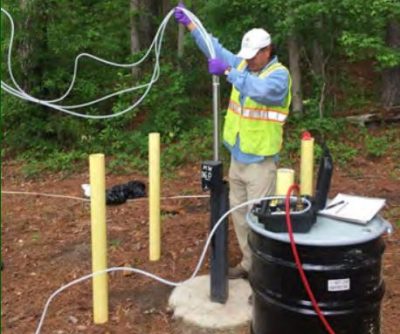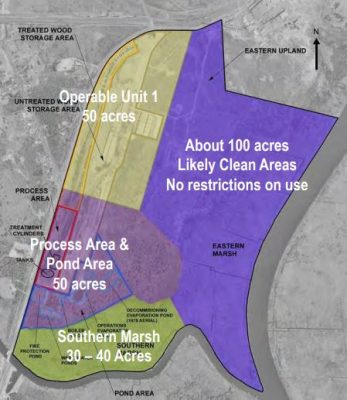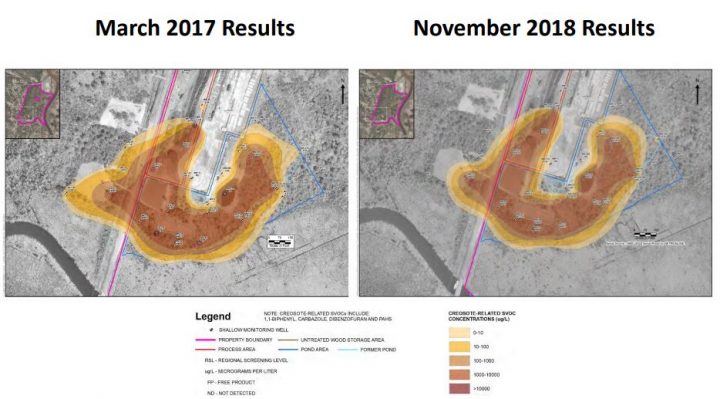This story was updated April 4 to clarify the roles of the two trusts involved and where restoration projects will take place.
NAVASSA – The U.S. Environmental Protection Agency is not going to ask for land use restrictions on nearly half of a former wood-treatment plant Superfund site here.
Supporter Spotlight

Erik Spalvins, the EPA’s remedial project manager for the former Kerr-McGee Chemical Corp. site, said Tuesday it will be up to Navassa officials to restrict, if they choose, through zoning the types of development permissible on 100 acres of the former wood-treatment plant site.
Tests confirm that those 100 acres of the 250-acre site are free of contamination. The EPA will place land-use restrictions on other areas of the site, including 50 acres with the highest contamination of creosote – the former processing and pond area.
Another 50 acres where treated wood was stored before it was shipped via rail offsite is lightly contaminated.
Spalvins said the 100 acres contaminated with creosote will be restricted from residential use.
Tests are ongoing in a marsh that spans 30 to 40 acres on the southern portion of the property, Spalvins said.
Supporter Spotlight
“We’re trying to get as much of this back into use as quickly as we can,” he said.
A record of decision will be released “as soon as possible,” he said, possibly before the end of September.
“I thought we would have done it three or four years ago, frankly, and I’m sorry that we haven’t,” Spalvins said.
He, officials with the North Carolina Department of Environmental Quality and those with the Multistate Trust hosted Tuesday what was originally supposed to be a quarterly meeting in the Brunswick County town. The meeting was initially scheduled for Feb. 26, but was pushed back as a result of delays caused by the 35-day government shutdown that ended Jan. 25.

Groundwater in nearly 60 monitoring wells drilled in and around the site will continued to be sampled every six months, said Richard Elliott, the Multistate Environmental Response Trust project manager of the Superfund site.
Tests continue to show that a plume of creosote in the groundwater remains in the same area since the plant closed more than 40 years ago.
“It’s not getting bigger,” Elliott said. “It’s not getting smaller. It’s not doing anything. It’s pretty much staying in place.”
Creosote has been found anywhere from 10 feet below the surface to as deep as 90 feet below the surface on the site, where the wood-treatment plant was operated under various companies from 1936 through 1974.
The property was added to the National Priorities List of federal Superfund sites in 2010 because of the contamination in the groundwater, soil and sediment.
Elliott explained that the creosote plume had not intersected with nearby Sturgeon Creek because the contamination is below the creek.
“The creosote goes down,” he said. “It’s heavier than water. It’s sinking and it’s not moving very fast.”
Samples taken within about 3½ acres of the 35-acre southern marsh area of the property indicate higher than allowable toxicity. Officials will continue to sample those areas of the marsh, Elliott said.

“The real question is, are those really a risk to the ecosystem?” he said. “The problem is that an ecosystem in a marsh is very, very sensitive. When you’re getting down to small areas you have to be real careful.”
Elliott said a finalized human health risk assessment, or HHRA, is nearly complete and likely to be submitted in April.
The results of the HHRA indicate the soils in the treated and untreated wood storage areas, the eastern upland area, and the southern marsh do not pose an unacceptable risk to human health.
The risk is, however, unacceptable for soils in the pond and process areas as well as where the groundwater contamination is located.
Elliott said that restrictions for land use will be included in property deeds as well as warnings about digging the land and what to do if creosote is discovered.
Plans this year include initiating a remedial design for the Superfund site, completing the feasibility study on the pond and process area, and conducting plume further studies of the plume.
“We’re going to start marketing the site,” Elliott said. “We’ve had a fair amount of interest. Right now, it’s zoned for industrial use. We need to work with the town to properly zone it.”
The EPA, in consultation with DEQ, oversees the Multistate Environmental Response Trust, which was court-appointed to own the Superfund site and is responsible for managing the remediation of the property.
Another trust, the Navassa Trustee Council, is responsible restoring natural resources in the area around the Superfund site damaged by contamination. This trustee council includes DEQ and other stakeholders from two federal government agencies.
Anjie Ackerman, planning specialist with DEQ’s Division of Mitigation Service’s Watershed Planning & Property Protection section, said that, so far, 26 proposals for how the land should be used had been submitted for consideration.
Not all 26 of the ideas will be recommended, she said.
These projects will most likely not take place on the actual Superfund site, but at least some are expected to impact the surrounding watershed.
“We can take project ideas now,” Ackerman said. “We can take projects this summer. Until the money is gone, we will take project ideas.”
Funding decisions will be made after the public has had the opportunity to comment.
Ackerman said a draft restoration plan will be released in the coming weeks. The release of the draft will be followed by a 45-day public comment period.
Ackerman said the targeted timeframe for the public comment is June or July.
The next EPA-hosted meeting on the Superfund site is set for June 25.








